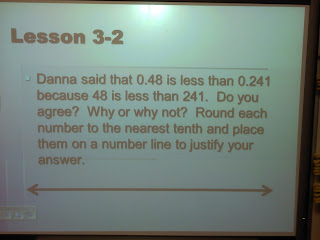Today I am proud to share that I received a print copy of my article published in Education Week! I am feeling very busy and important, as Bridget Jones would say (Not so important that the editor didn't address my congratulatory letter to Mr. Doyle accidentally, however... oh well).
Yesterday, I officially starting using Common Core Math Journal tasks in my classroom. I got them from an awesome website,
K-5 Math Teaching Resources, which has amazing, FREE resources that are aligned to the Common Core. The
Math Journals and the Flip Books are my favorite. The math journals, or "problem solving notebooks" feature tasks that invite students to think a little deeper, explain their thinking, and justify their answers. Sounds like Common Core to me! I put this problem up on my Smartboard yesterday:
 |
When I first put it up, it just showed up to "Do you agree?"
|
I had my students read it to themselves, then I read it aloud, and then they read it to their elbow partners. I asked them to write their answer on their whiteboards: Yes or No. Most wrote down their answers very quickly, but a few took a second to ponder. When I asked them to "show me", more than half the class had answered yes, that they indeed agreed that 0.48 is less than 0.241. I then put up the next question - why or why not? I got a few confused looks... wait, you want me to justify my answer!? (Despite the fact that our language objective for the day was indeed, "I will justify my answer by using an "I think... because..." statement.)
As I walked around the room, here are some of the responses I saw:
 |
| Sandra was stuck on the place value names. Thousandths sounds bigger than hundredths because 1000 > 100! |
 |
| Mariana totally got it, though she struggled with putting her reasoning into words. I prompted her, "What about adding a zero helped you make your decision?" |
 |
| Jimena attempted to justify her answer on a number line. Clearly her understanding of hundredths and tenths needs to be developed further! |
 |
| Jose was on the right track. He had his number line partitioned into tenths and was able to place 0.48, but didn't quite get to the 0.241. |
 |
| Elizabeth drew this beautiful place value chart, placed the numbers correctly, and still stuck to her guns on agreeing that 0.48 < 0.241! |
We debriefed as a class, using this interactive,
zoomable number line as a tool for understanding what hundredths and thousands actually look like on the number line.
 |
| Sandra changed her mind after our class discussion. Her justification still needs to be developed so she can articulate her thinking. |
This was fifteen minutes well spent, as it helped me really see the need my class had for this deeper, critical thinking. I have some misconceptions to address! One of the common misconceptions mentioned in the Common Core Flipbook for 5th grade relating to comparing numbers is the idea that the longer the number, the greater the number. While this is true for whole number (a 5 digit number will always be bigger than a 4 digit number, etc), decimals turn this on its head. I showed my students how to add "bumper" (or placeholder) zeros to the numbers to make them all the same number of digits. We'll see how well this sticks when I try another problem like this on Monday!
(In case you were curious, the Common Core Standard this addresses is 5.NBT.3 Read, write, and compare decimals to thousandths.)










Comments
Post a Comment